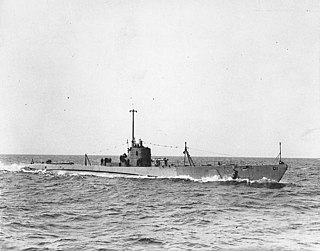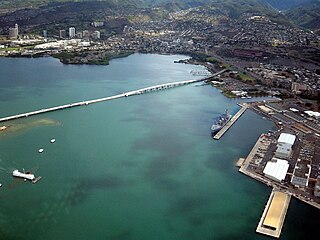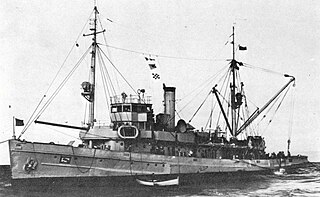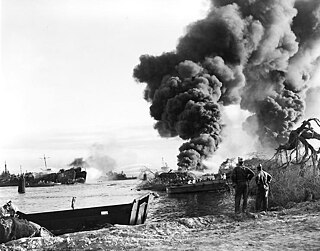
USS Dolphin (SF-10/SC-3/SS-169), a submarine and one of the "V-boats", was the sixth ship of the United States Navy to be named for that aquatic mammal. She also bore the name V-7 and the classifications SF-10 and SC-3 prior to her commissioning. She was launched on 6 March 1932 by the Portsmouth Navy Yard, sponsored by Mrs. E.D. Toland, and commissioned on 1 June 1932.

USS Skate (SS-305) was a Balao-class submarine in service with the United States Navy from 1943 to 1946. She was used as a target ship in the 1946 atomic bomb tests and finally sunk as a target ship in October 1948.

USS Sailfish (SS-192), was a US Sargo-class submarine, originally named Squalus. As Squalus, the submarine sank off the coast of New Hampshire during test dives on 23 May 1939. The sinking drowned 26 crew members, but an ensuing rescue operation, using the McCann Rescue Chamber for the first time, saved the lives of the remaining 33 aboard. Squalus was salvaged in late 1939 and recommissioned as Sailfish in May 1940.

USS F-1 (SS-20) was an F-class submarine. She was named Carp when her keel was laid down by Union Iron Works of San Francisco, California, making her the first ship of the United States Navy named for the carp. She was launched on 6 September 1911 sponsored by Ms. J. Tynan, renamed F-1 on 17 November 1911, and commissioned on 19 June 1912.

USS S-4 (SS-109) was an S-class submarine of the United States Navy. In 1927, she was sunk by being accidentally rammed by a United States Coast Guard destroyer with the loss of all hands but was raised and restored to service until stricken in 1936.

USS G-1 (SS-19½) was the lead ship of her class of submarine of the United States Navy. While the four G-boats were nominally all of a class, they differed enough in significant details that they are sometimes considered to be four unique boats, each in a class by herself.

USS Brill (SS-330), a Balao-class submarine, was a ship of the United States Navy in commission from 1944 to 1947. She was named for the brill, a European flatfish.

The Pearl Harbor Naval Shipyard and Intermediate Maintenance Facility is a United States Navy shipyard located in Pearl Harbor, Hawaii on 148 acres. It is one of just four public shipyards operated by the United States Navy. The shipyard is physically a part of Joint Base Pearl Harbor–Hickam.

USS S-29 (SS-134), was a first-group S-class submarine of the United States Navy. During World War II, she also served in the Royal Navy as HMS P556.

Admiral Clarey Bridge, also known as the Ford Island Bridge, is a 4,672 ft (1,424 m) road bridge that connects Ford Island in Pearl Harbor to the mainland of Oahu, the third-largest island of Hawaii. A 930 ft (280 m) section of it is supported by pontoons, and can be moved to allow vessels to pass through. This floating moveable span is the largest in the world.

A United States Navy diver refers to a service personnel that may be a restricted fleet line officer, civil engineer corps (CEC) officer, Medical Corps officer, an Unrestricted Line Officer who is qualified in Explosive Ordnance Disposal (EOD) Warfare (1140) or an enlisted who is qualified in underwater diving and salvage. Navy divers serve with fleet diving detachments and in research and development. Some of the mission areas of the Navy diver include: marine salvage, harbor clearance, underwater ship husbandry and repair, submarine rescue, saturation diving, experimental diving, underwater construction and welding, as well as serving as technical experts to the Navy SEALs, Marine Corps, and Navy EOD diving commands.

USNS Salvor (T-ARS-52) is a Safeguard-class rescue and salvage ship, the second United States Navy ship of that name.

The first USS Ortolan(AM-45/ASR-5) was a Lapwing-class minesweeper in the United States Navy. She was later converted to a submarine rescue ship. She was named after the ortolan, a European bunting.
The G-class submarines were a class of four United States Navy submarines. While the four G boats were nominally all of a class, they differed enough in significant details that they are sometimes considered to be four unique boats, each in a class by herself. They were the result of agitation for competition in submarine design; all previous US submarines were designed by Electric Boat. G-1, G-2, and G-3 were designed by Simon Lake of the Lake Torpedo Boat Company, while G-4 was designed by American Laurenti. G-1 and G-2 were built by Newport News, G-3 by Lake, and G-4 by Cramp.

Frank William Crilley was a United States Navy diver and a recipient of the United States military's highest decoration, the Medal of Honor.

The West Loch Disaster was a maritime accident during World War II at Pearl Harbor U.S. Naval Base in Hawaii. The incident, which occurred just after 3 p.m. on Sunday, 21 May 1944, began following an explosion in a staging area for Landing Ships, Tank (LSTs) and other amphibious assault ships in West Loch. A fire quickly spread among the ships being prepared for Operation Forager, the invasion of the Japanese-held Mariana Islands. Over the next 24 hours, six LSTs sank, 163 naval personnel died, and 396 were injured.

Julius Augustus Furer was a highly decorated naval architect and an engineer in the United States Navy with the rank of rear admiral. During World War II, Furer served as coordinator of research and development and the senior member of the National Research and Development Board.

Naval Station Pearl Harbor is a United States naval base on the island of Oahu, Hawaii. In 2010, as part of the recommendations of the Base Realignment and Closure (BRAC) commission, the naval station was consolidated with the United States Air Force's Hickam Air Force Base to form Joint Base Pearl Harbor–Hickam. Since 1940, Pearl Harbor has been the headquarters of the United States Pacific Fleet.

The United States Navy built permanent and temporary submarine bases around the world to maintain its fleet of submarines and serve the needs of the crews. Submarine bases are military bases that offer good fleet anchorage and are designed to refuel and resupply submarines. The peak number of US submarine bases was during World War II, as the submarine was well suited for fighting in the vast Pacific War, often in enemy waters. Many of the United States submarine bases were closed after the war.

Naval Base Hawaii was a number of United States Navy bases in the Territory of Hawaii during World War II. At the start of the war, much of the Hawaiian Islands was converted from tourism to a United States Armed Forces base. With the loss of US Naval Base Philippines in Philippines campaign of 1941 and 1942, Hawaii became the US Navy's main base for the early part of the island-hopping Pacific War against Empire of Japan. Naval Station Pearl Harbor was founded in 1899 with the annexation of Hawaii.























